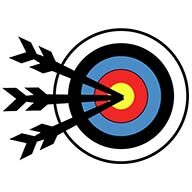The follow-through is the last step in the shooting procedure. You often hear archers and coaches say that a good follow-through is very important. But if you ask what you should do, you probably get a vague answer. It’s simple to spot a bad follow-through, but it’s quite hard to describe how you should follow through. Let me give you a short answer in case you are in a rush:
For a good follow-through, you should keep your body in shooting position until the arrow hits the target. So, don’t lower the bow arm or twist the bow while the arrow is still in flight. This makes sure that you don’t accidentally interfere with the arrow while it clears the bow.
In this article, I discuss how to mast the follow-through in much more detail. But first I discuss what we mean with follow through. Then I explain why a good follow-through is so important. At the end of this article, I talk about the free-fall swing technique and some common mistakes to avoid.
Before we start
Although I try to make this guide as complete as possible, it’s not possible to cover all minute aspects. Therefore, this guide aims to give you the basics. If you are serious about archery, I would highly recommend taking an archery course or hiring an archery coach.
I understand that hands-on coaching is not always available for everyone. Luckily there is a great (in my opinion even better) alternative – following an online course from the Online Archery Academy. With video examples and detailed explanations, these courses are a great way to improve your archery. I can personally vouch for them, as I have also taken the courses.
Readers from this blog will get a discount of 20% if you use the discount code IYA at checkout. If you don’t think the courses help you improve your archery, you can always use the 100-day money-back guarantee.
What follow-through is in archery
For new archers, the concept of follow-through is often unclear. So, let me explain what follow-through is:
The follow-through in archery happens right after you release the string. All movements until the arrow hits the target are considered part of the follow-through. Especially the first part of the follow-through is important because the arrow is then still clearing the bow.
So, it’s important to have a consistent follow-through that doesn’t cause interference with the arrow.
Why the follow-through is important
For most new archers, the focus on follow-through seems a bit unnecessary. If you just keep the bow still until the arrow leaves the bow nothing should happen right? That is indeed true, but it’s impossible to freeze your body, especially because all the tension disappears in an instant. Therefore, we need a good follow-through to make sure that you only apply pressure toward your target.
This is comparable to follow through is important in a lot of other sports. Think for example about basketball, baseball, volleyball, and golf. The thing that all these sports have in common is that accuracy of the throw or swing is vitally important.
A follow-through makes sure that you don’t influence the arrow in a direction you don’t want. Lowering the bow too early will cause the arrow to fly low for example. Or jerking the bow left or right, will cause the arrow to fly left or right.
The technique
We already discussed the basic technique, but there is much more to discuss.

Bow arm
For a proper follow through you must keep your bow arm up until the arrow clears the riser. Generally, we do recommend archers to keep their bow up until the arrow hits the target. That’s because it’s often difficult to see whether your arrow has cleared the riser. So, to be on the safe side it’s better to keep it up longer.


Make sure to keep your bow arm as steady as possible during the follow-through. Any sideways or up or down movement might cause interference with the arrow.
Therefore, make sure that you don’t shoot with a bent arm. It’s impossible to keep a bent arm steady when all the tension from the bow disappears when you release it. This often makes you push the bow up unintentionally. Make sure though that you don’t lock your elbow, this can cause additional vibration in your shots.
There are also a lot of other reasons why you want to shoot with a straight arm, which you can read here:
Shooting with a bent vs straight arm



Bow hand
Most people are afraid of dropping the bow. They think that the bow may fly out of their hand. Therefore, they hold the bow very firmly. But that is not something you want to do because this will make it very easy to twist or jerk the bow upon release.
Therefore, you want to have a relaxed grip. I would even recommend shooting with an open hand. Don’t be afraid that the bow drops to the ground. Your reflexes will kick in and catch it, but then the arrow will be long gone.
Also don’t overdo it though. You can also shoot with an open hand while tensing your muscles. Although that is better than shooting with a firm closed grip it’s still not ideal. So, make sure that you are gripping your bow correctly. The article below will provide you with additional guidance:



Draw arm
While you are aiming and releasing your arm should pull straight backward in line with the string and arrow. When you fire the shot, all the energy will be released. Therefore, it’s normal that your arm flies backward.
This has the added benefit that the hand gets away from the string as fast as possible. Which makes it less likely that you influence the flight pattern of the arrow.


Draw hand
You release the bow simply by relaxing the draw hand. You don’t have to forcefully straighten your fingers, that could only cause consistency issues. The force of the string will push the fingers out of the way. Just make sure to relax your fingers after the release.
Read the article below, for more information on how to improve your release:
The free-fall swing
Earlier I recommended shooting with an open bow hand, but a lot of recurve archers take this one step further. They don’t catch the bow but let it fall completely. If you do this with a device called a finger sling, the bow will be caught which causes the bow to swing. This might seem quite strange if you haven’t seen it before. You can see the swing happen in the video below:
The idea behind the free-fall swing is that you make sure that you don’t grip the bow tightly. If the bow falls and swings you know that you haven’t gripped it too tightly. Some archery coaches also use the swing to identify inconsistencies in the archer’s technique.
The free-fall swing is quite an advanced technique. So, therefore, it’s not recommended for new archers. It’s also not necessary to swing your bow, as I discuss in more details why in the article below:
Is it really necessary to swing your bow?
Common mistakes to avoid
A good follow through doesn’t have to be difficult. If you at least avoid the common mistakes listed below you will have about 99% of the technique down.
Death grip
Earlier we discussed that you shouldn’t have a firm grip on the bow. This is one of the biggest mistakes most archers make when they are getting started. It makes sense that you want to control the movement of the bow, but as discussed earlier this is counterproductive.
So, shoot with an open hand and let the bow shoot forward in your hand. Your reflexes will kick in and you will automatically catch the bow. Make sure to use either a finger or wrist sling though. I never saw an archer drop their bow, you want to be on the safe side.
For beginners, I would recommend buying a finger sling. For more information about the difference between finger and wrist slings, read the article below:
Are finger slings better than wrist slings?
Lowering the bow too soon
Another common mistake is to lower the bow too soon. As mentioned earlier you must keep your bow arm straight until the arrow has completely cleared the bow. Otherwise, you might hit the arrow while you move the bow down.
Twisting the bow hand
While you shoot the bow, you should make sure that you are not twisting your hand. This often happens when you have a firm grip on the bow, but it can also happen with a more relaxed grip. Make sure that you are only pushing the bow straight forward!
Target panic
Flinching during the release (also known as target panic) is a common issue amongst experienced archers. This issue happens when you anticipate the release too much, which causes your body to stiffen up.
Your body is expecting sudden movement and therefore tensions the muscles. This is similar to why a lot of people experience muscle strain after being in a car crash.
Target panic can decimate the scores of an experienced archer. Therefore, it’s a real frustrating issue since it happens automatically. This means that there are no easy fixes. For more information on target panic and how to solve the issue, read the article below:
How to prevent flinching in archery (aka target panic)
The shot cycle
The final step in the shot cycle is the follow-through. For more information about the other steps, check out the articles listed below:
How to shoot a bow (an overview)
- Step 1: stance
- Step 2: nocking
- Step 3: grip the bow
- Step 4: grip the bowstring
- Step 5: maintain the right form
- Step 6: draw the bow
- Step 7: anchor
- Step 8: aim
- Step 9: release
- Step 10: follow-through (this article)
Final words
Probably the most important tip to master the follow-through is to stand like you are still aiming while the arrow is airborne. This might feel strange at first, but if you look at professional archers, they all do it.
It simply makes sure that you are not interfering with the arrow and it also allows you to analyze your technique. So, waiting a bit longer than you normally do can help improve your accuracy.
Before you go, don’t forget to use the coupon code IYA if you are buying one of the courses from Online Archery Academy. As mentioned earlier, I highly recommend taking a structured course. As this will greatly deepen your archery knowledge and skill.
If you have any comments, suggestions, feedback, or questions, please let me know. You can leave anything you want to share in the comment section below. I will reply to your comment as soon as possible and I will send you an email notification with my reply.
Tim van Rooijen
For as long as I can remember, I have always been fascinated by archery. First due to its historic significance but later because I like being outdoors. With this blog, I share my knowledge about Archery and how you can improve your shot. More about author…

